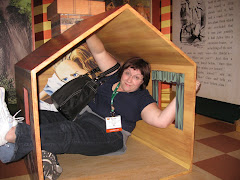A short bit on designing for critical thinking/dialogue. Some bits of this were originally part of an article I co-authored for the Fall 2007 issue of Museums and Social Issues. This bit was unfortunately cut, but I feel like revisiting it.
Museums are not classrooms. We hear it constantly; we repeat it constantly. Attempts to bring classroom methods to museums are often met with heavy resistance. Partly this is because many attempts to integrate classroom philosophies into museums fail to adapt to the unique environment of non-formal education. Partly this may be because museums pride themselves on being non-formal, and thus fail to see the value in philosophies based in formal education.
Whatever the reason, I find myself stuck trying to find real ways to effect the goals of critical pedagogy in the museum setting. True critical pedagogy, as championed by Friere and others, requires a skilled facilitator to help participants through the process of learning. In much of the reading so far, it seems that facilitation remains the best way to stimulate dialogue and critical learning. So how can we facilitate, through an exhibit, without a guide or docent?
Exhibits communicate in several ways: through objects, interpretive text and design. So, how can an exhibit, without a single person to facilitate, encourage dialogue and inspire visitors to think critically about their world? What elements of design and development encourage critical thought and dialogue? Conversely, what elements may inadvertently communicate hegemony and positions of power?
In the original incarnation of the article “Can You Do That?,” we included a section on designing for dialogue. I would like to further investigate this concept and find an avenue for publication. I think that exhibit design often gets overlooked in favor of programming, but many museums cannot support long term programming with professionally trained facilitators.
Objects:
• As indicated in the Hooper-Greenhill, “objects do not speak for themselves…objects are spoken.” Every exhibit displays curatorial choices in display. Linked objects, display context, use of images and object display style all communicate to the public. The choice of object displayed can communicate ideas about power and control as well.
Labels:
• Labels are generally the way that museums communicate through exhibits. Labels should strive against being overly didactic and should serve to stimulate critical thinking. As per Lindauer, labels can be used to disrupt hegemony and displace authority. Prompting questions can also serve to stimulate dialogue.
Design:
• Comfort! Critical thinking is uncomfortable. Dialogue is uncomfortable. If you try to combine these with an uncomfortable physical environment, you set yourself up to fail. Soft seating, pleasant lighting, protected spaces, etc, all can lead to enhanced opportunities for dialogue and thinking.
• Placement of exhibits and components is important. What message does it send if an exhibit about this history of communities of color is tucked back in a seldom visited corner? Or if an exhibit on migrant farm workers is displayed in a poorly organized hallway? Likewise, if hegemonic displays are given a place of prominence, it sends a similar message.
More on this to come.


